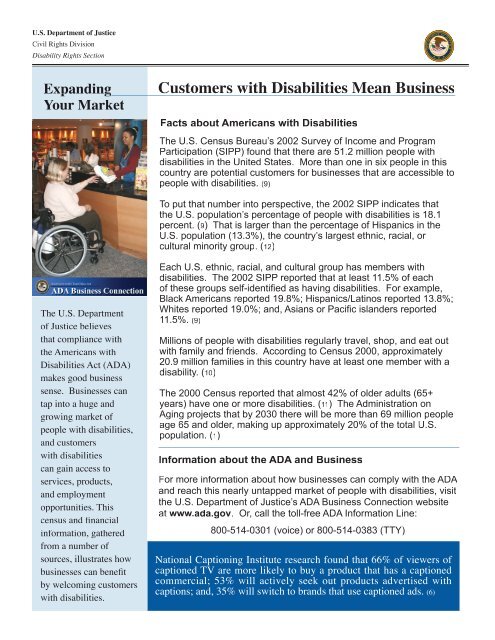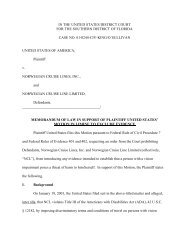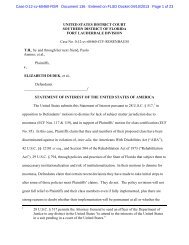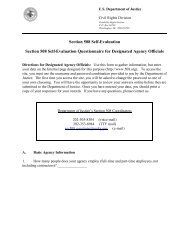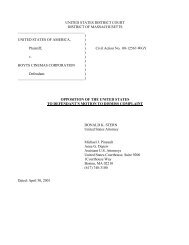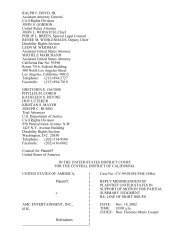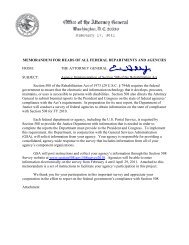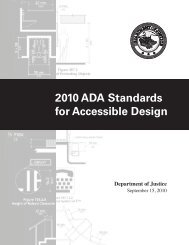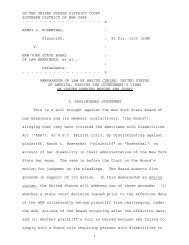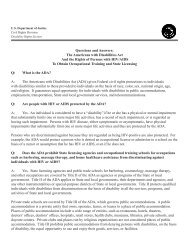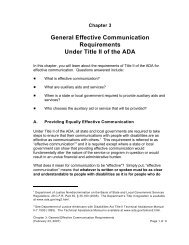Customers with Disabilities Mean Business - ADA.gov
Customers with Disabilities Mean Business - ADA.gov
Customers with Disabilities Mean Business - ADA.gov
- No tags were found...
Create successful ePaper yourself
Turn your PDF publications into a flip-book with our unique Google optimized e-Paper software.
U.S. Department of JusticeCivil Rights DivisionDisability Rights SectionExpandingYour Market<strong>Customers</strong> <strong>with</strong> <strong>Disabilities</strong> <strong>Mean</strong> <strong>Business</strong>Facts about Americans <strong>with</strong> <strong>Disabilities</strong>The U.S. Census Bureau’s 2002 Survey of Income and ProgramParticipation (SIPP) found that there are 51.2 million people <strong>with</strong>disabilities in the United States. More than one in six people in thiscountry are potential customers for businesses that are accessible topeople <strong>with</strong> disabilities. (9)To put that number into perspective, the 2002 SIPP indicates thatthe U.S. population’s percentage of people <strong>with</strong> disabilities is 18.1percent. (9) That is larger than the percentage of Hispanics in theU.S. population (13.3%), the country’s largest ethnic, racial, orcultural minority group. (12)The U.S. Departmentof Justice believesthat compliance <strong>with</strong>the Americans <strong>with</strong><strong>Disabilities</strong> Act (<strong>ADA</strong>)makes good businesssense. <strong>Business</strong>es cantap into a huge andgrowing market ofpeople <strong>with</strong> disabilities,and customers<strong>with</strong> disabilitiescan gain access toservices, products,and employmentopportunities. Thiscensus and financialinformation, gatheredfrom a number ofsources, illustrates howbusinesses can benefitby welcoming customers<strong>with</strong> disabilities.Each U.S. ethnic, racial, and cultural group has members <strong>with</strong>disabilities. The 2002 SIPP reported that at least 11.5% of eachof these groups self-identifi ed as having disabilities. For example,Black Americans reported 19.8%; Hispanics/Latinos reported 13.8%;Whites reported 19.0%; and, Asians or Pacifi c islanders reported11.5%. (9)Millions of people <strong>with</strong> disabilities regularly travel, shop, and eat out<strong>with</strong> family and friends. According to Census 2000, approximately20.9 million families in this country have at least one member <strong>with</strong> adisability. (10)The 2000 Census reported that almost 42% of older adults (65+years) have one or more disabilities. (11) The Administration onAging projects that by 2030 there will be more than 69 million peopleage 65 and older, making up approximately 20% of the total U.S.population. (1)Information about the <strong>ADA</strong> and <strong>Business</strong>For more information about how businesses can comply <strong>with</strong> the <strong>ADA</strong>and reach this nearly untapped market of people <strong>with</strong> disabilities, visitthe U.S. Department of Justice’s <strong>ADA</strong> <strong>Business</strong> Connection websiteat www.ada.<strong>gov</strong>. Or, call the toll-free <strong>ADA</strong> Information Line:800-514-0301 (voice) or 800-514-0383 (TTY)National Captioning Institute research found that 66% of viewers ofcaptioned TV are more likely to buy a product that has a captionedcommercial; 53% will actively seek out products advertised <strong>with</strong>captions; and, 35% will switch to brands that use captioned ads. (6)
References1. Administration on Aging. “Statistics:Aging into the 21st Century.” October2003. (26 April2004).Spending Power of Americans <strong>with</strong> <strong>Disabilities</strong>The large and growing market of people <strong>with</strong> disabilities has $175billion in discretionary spending, according to the U.S. Departmentof Labor. (13) $175 billion is more than four times the spendingpower of tweens (8-14 year-olds), a demographic sought after bybusinesses. (3)An Open Doors Organization study estimated in 2003 that diners<strong>with</strong> disabilities would spend $35 billion in restaurants that year.The study found that more than 75% of people <strong>with</strong> disabilities eatout at restaurants at least once a week. (7)The New York Times reported that spending by travelers <strong>with</strong>disabilities exceeds $13.6 billion annually. (5)AARP says that four million Americans turn 50 each year and thatpeople age 50 and older spent nearly $400 billion in 2003. (4)At age 50, adults are likely to experience age-related physicalchanges that may affect hearing, vision, cognition, and mobility.While they may not think of themselves as having disabilities,people in this age group often seek out businesses thataccommodate those changes by offering better lighting, lessambient noise, and fewer stairs.People <strong>with</strong> <strong>Disabilities</strong> GloballyThe World Health Organization (WHO) estimates that thereare 600 million people <strong>with</strong> disabilities around the world. (13)Examples of the global spending power of people <strong>with</strong> disabilitiesinclude:• United Kingdom: The Employers’ Forum on Disabilityestimated in 2005 that there are 10 million adults <strong>with</strong>disabillities in the UK. The estimated annual purchasing powerof people <strong>with</strong> disabilities there is £80 billion. (2)• Canada: The Conference Board of Canada reported in 2001that the combined annual disposable income of working-agedCanadians <strong>with</strong> disabilities was CAN $25 billion. (8)For more information about the <strong>ADA</strong> and business, visit the Department ofJustice <strong>ADA</strong> <strong>Business</strong> Connection at www.ada.<strong>gov</strong>. Or, call the toll-free <strong>ADA</strong>Information Line: 800-514-0301 (voice)800-514-0383 (TTY)July 2006Duplication of this document is encouraged.2. Employersʼ Forum on Disability.“Disability in the UK - 2005.” (21 September 2005).3. Paul Farhi and Jennifer Frey. “MarketersTune In to the Tween Set; New Mediatarget a Rich Niche of Young Consumers”washingtonpost.com.23 May 2006. (23 May 2006).4. Nat Ives. “AARP Aims to DeliverMessage to Marketers” The New YorkTimes. 12 January 2004. (12 January 2004).5. David Koeppel. “<strong>Business</strong> Travel:Hotels Learn to Deal <strong>with</strong> Disability” TheNew York Times on the Web. 17 February2004. (28 February2005).6. NCI. “Commercial and InfomercialCaptioning.” n.d. (16 September 2004).7. PNN Online. “People <strong>with</strong> <strong>Disabilities</strong>Will Spend Nearly $35 Billion Dining Outin 2003.” 20 May 2003. (21 April 2004).8. The Conference Board of Canada.“Tapping the Talents of People<strong>with</strong> <strong>Disabilities</strong>.” 2001. (24 September 2004).9. U.S. Census Bureau. “Americans <strong>with</strong><strong>Disabilities</strong>: 2002 Household EconomicStudies.” May 2006. 15 May2006.10. U.S. Census Bureau. “Disability andAmerican Families: 2000.” July 2005. (7 April 2006).11. U.S. Census Bureau. “DisabilityStatus 2000.” March 2003. (16February 2005).12. U.S. Census Bureau. “The HispanicPopulation in the United States: March2002.” June 2003. (17 July2006).13. U.S. Department of Labor. “ProvidingQuality Services to <strong>Customers</strong> <strong>with</strong><strong>Disabilities</strong>.” July 1998. (27 September 2004).14. World Health Organization. “Access toRehabilitation for the 600 Million PeopleLiving <strong>with</strong> <strong>Disabilities</strong>.” 3 December2003. (4 August 2004).


